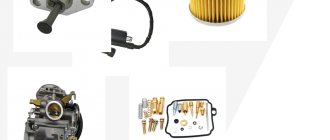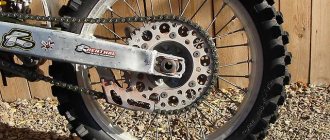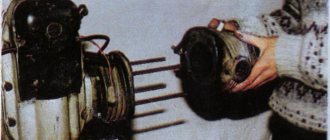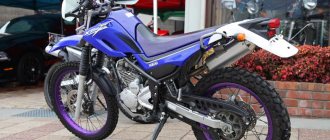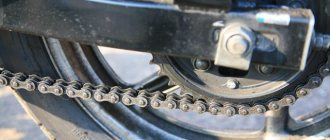Cheap doesn't always mean bad. Especially if we are talking about the Yamaha Serow 225 bike. Having debuted in 1987, it became the ideal solution for people who love enduro , but at the same time live and work in the “ asphalt jungle ”. The model lived on the assembly line for 15 years, and at the beginning of the new century it was considered obsolete and production was closed.
The budget price made it possible to buy it as an addition, a second or even a third bike. But good suspension, engine protection, and low fuel consumption made it possible to use the motorcycle as the main everyday means of transportation.
Design of Yamaha SEROW 225
The developers have worked hard to create an SUV and at the same time make it not too expensive. Its popularity is evidenced by the many auction lots in Japan that were purchased by Russian suppliers.
In white and yellow plastic.
Side view.
From auction.
A cast steel frame with a minimum number of welds, good rigidity, precise engineering calculations, and the resulting “child” had virtually no problems either off-road, on asphalt, or when overcoming high passes. Equally good performance in all conditions.
It is not profitable to use some innovative solutions when designing a budget motorcycle, so many parts can be called classics.
- The front suspension is based on a telescopic fork , the rear is a pendulum with a mono-shock absorber . It’s interesting that the budget bike has the ability to adjust the preload.
- The working stroke of the fork is 225 mm , the rear part is 145 .
Yamaha is on point.
The model uses a standard frame design, but the height of the saddle clearly targets the bike only for tall consumers, which is not surprising, since the motorcycle was developed only for export. Unlike many other developments, the TW 225, a logical continuation of the line and intended only for domestic markets, began to be produced not in parallel, but after the export model was discontinued. The debut of the version for domestic sales dates back to 2002 .
Exterior
When considering the Yamaha Serow, the first thing that catches your eye is its off-road use.
They are chasing them by the tail and by the mane! The motorcycle turned out to be very successful.
The engine protection is excellent, the steel covers not only the lower part, small wings even protrude from the sides. Coated pipes and a narrow radiator complete the feel.
Front end
There are no large body kits in the front part; some may even think that there are not enough of them.
A minimum of body kit, no windshield - why is this needed off-road? As my coach used to say: “Drop it anyway.”
- A large wing raised to the maximum height, a small opening and a head optics unit with a small body kit on the sides of the headlight. She's here alone, square-looking. Slightly recessed, which emphasizes the ability to move over rough terrain.
- The direction indicators are on the sides of it, mounted on the fork stays.
- There is no windshield , the minimum amount of plastic also does not make it possible to install a tuned one, but according to users, it is not needed here. The steering wheel is low, there are no adjustments, but it is set at such a height that the height of the motorcyclist will not affect the control.
- The rear mirrors are round and widely spaced (the centers are above the ends of the grips), which is probably why there is only one adjustment - turning them from side to side. It shouldn't interfere with off-road driving. They are installed quite high, which gives a certain advantage for driving between rows - automobile ones are located lower.
A sad photo, but the byte is excellent. This is exactly the case where you get a lot of motorcycle for your money.
Dashboard
The set of indicators is small. In front of the motorcyclist is an analogue speedometer, here it is non-standard - rectangular and several indicators.
The dashboard includes the minimum necessary tools.
The odometer is built into the speedometer, the mileage is indicated in the form of a small window familiar to motorists. The ignition key is here, but the developers took into account that there is no wind protection, so they moved it down to the side.
Gas tank
The gas tank, with a capacity of almost 10 liters, lies in front of the driver on the frame, but thanks to the successful color scheme of the models, it is almost invisible.
A gas tank of almost 10 liters will allow you to travel about 250 km to a gas station. Depends on the driving mode.
The only part that stands out is the lid, but it is also pushed as close to the dashboard as possible. Regardless of the external design of the motorcycle, it is painted black for better camouflage.
Rear end
An interesting decision by the designers was the appearance of reflectors (reflectors) as a continuation of the rear body kit. Since there is no mudguard, one was attached to the lowest point of the body kit.
Reflectors as an extension of the body are an interesting and practical solution.
After the change of generations, the reflector disappeared, and the clearance moved in its place.
- The brake light , made in a separate housing, is located slightly higher. Although the turn indicators are spaced apart, there was no need to provide a separate mount for them - they fit well on a rather wide rear body kit, non-standard for the brand.
- There is no wing provided ; its role is played by the frame, but there is still protection for the rear passenger. The end of the body kit is bent down. There is no single standard for a saddle. The design depends on the specific bike; there are both single-seat and double-seat modifications.
- There is no seat bag , so some users installed a pannier bag. However, the area for it is minimal. An unusual detail for enduro was the raising of the rear part of the muffler almost under the saddle. But the developers went even further. In the latest models, a small frame was made on the raised part of the muffler - a mount for side cases.
No pannier, no fender. But these are all minor things. which you can close your eyes to.
Power point
According to users, despite the fact that the engine is single-cylinder, its power is enough to overcome even large obstacles and climb mountains of moderate height. The engine developed for this model became quite successful, which led to its use not only on this model.
The power plant honestly works out the power of its 21 horsepower. Someone wants more, he takes the Honda CRM 250, there are 39 of them.
It was a 4-stroke type and had 1 piston:
- working volume - 223 cm3;
- power - 21 hp;
- maximum torque - 19 Nm;
- number of valves - 2;
- cooling - air;
- fuel supply - carburetor, 34 mm;
- ignition - electronic;
- start - electric starter (kick starter leg is also provided).
The engine did not have any innovative solutions, with the exception of enlarged carburetor ribs, so it was reliable and unpretentious in maintenance.
Transmission and clutch
With relatively low engine power, the motorcycle received a 6-speed gearbox.
Many people start in second gear, since first speed is very short.
According to users, the box is ideal for off-road riding. The first gear has minimal travel, and given the traditional location of neutral in front of the second, it is better to move away in a higher gear. It’s not always convenient for the city, but for enduro riding it’s justified.
- Chain drive.
- The clutch is a classic multi-plate clutch for Yamaha bikes , oil bath .
Brakes
The first versions were equipped with rear drum brakes.
There were no differences in the brakes either. Until 1996 (generation change), drum versions were placed at the rear. Later models had disc ones.
To reduce cost, the diameter of the disks was made the same, and one disk was installed on both axles.
Front:
- disc diameter 220 mm ;
- 2 piston caliper.
Rear:
- disc diameter 220 mm ;
- 1 piston caliper.
Naturally, no options were provided for the budget version.
Posts 1 page 20 of 20
Share12010-10-29 10:43:56
- Author: Kuler
- old man
- From: MO
- Registered: 2010-10-26
- Invitations: 0
- Posts: 604
- Respect: [+28/-0]
- Positive: [+28/-0]
- Time spent on the forum: 4 days 22 hours
- Last visit: 2020-05-14 11:19:23
Yamaha TW200 valve adjustment is shown on the XT225 motorcycle, because...
the engine is identical. Photos taken from here https://www.xt225.com/forums/ubbthreads. … mp;fpart=1 The engine must be cold!
Remove the seat and two plastic sides. Disconnect the fuel hose from the gas tank while closing the fuel valve.
Edited by Kuler (2010-10-29 11:24:08)
Share22010-10-29 10:46:13
- Author: Kuler
- old man
- From: MO
- Registered: 2010-10-26
- Invitations: 0
- Posts: 604
- Respect: [+28/-0]
- Positive: [+28/-0]
- Time spent on the forum: 4 days 22 hours
- Last visit: 2020-05-14 11:19:23
Using a large flat screwdriver, unscrew the two plastic plugs on the left crankcase cover.
Share32010-10-29 10:47:15
- Author: Kuler
- old man
- From: MO
- Registered: 2010-10-26
- Invitations: 0
- Posts: 604
- Respect: [+28/-0]
- Positive: [+28/-0]
- Time spent on the forum: 4 days 22 hours
- Last visit: 2020-05-14 11:19:23
Using a socket wrench, unscrew the two valve adjustment window covers.
Edited by Kuler (2010-10-29 11:13:21)
Share42010-10-29 10:48:43
- Author: Kuler
- old man
- From: MO
- Registered: 2010-10-26
- Invitations: 0
- Posts: 604
- Respect: [+28/-0]
- Positive: [+28/-0]
- Time spent on the forum: 4 days 22 hours
- Last visit: 2020-05-14 11:19:23
Using a 17mm wrench, turn the crankshaft counterclockwise, while looking through the top window to align the “T” mark.
NOTE: To make cranking easier, remove the spark plug in advance.
ATTENTION: since the engine is 4-stroke, aligning the mark in the window is not sufficient. It is necessary to control the valve pushers while the crankshaft is rotating, i.e. when the marks are aligned, at one moment the valves can be clamped, and when the marks are subsequently aligned (next revolution), the valves are free. In this case, it is better to control it with a thin strip of a feeler gauge inserted between the pusher and the valve. That is, when, when aligning the mark, the dipstick does not fit between the pusher and the valve, we turn the crankshaft one more revolution until the mark is aligned, then the dipstick will pass. This can also be controlled visually: when the valve tappets rise, you can begin to adjust.
Driving performance
Has anyone tried to set the needle to more than 120 km/h in winter?
The speedometer markings correspond to the passport specifications - a little more than 120. Users were able to accelerate so that the needle lay down - approximately 135 km/h .
There was still a small reserve of power left - the lack of wind protection and unbalanced aerodynamics hampered it. Later, the developers noted that the violation of aerodynamics is not a mistake, but a distinctive feature. Why such speeds on enduro?
Fuel consumption
Fuel consumption during normal driving around the city was 3-3.5 liters. When driving on country roads it rarely rose above 2.
The final results depended on the quality of the canvas.
Acceleration to hundreds
9 seconds to hundreds is a good indicator for this class of motorcycle.
Acceleration to 100 was 9 seconds - a standard speed for the line. The same results were shown by bikes assembled on this basis.
Technical specifications
Technical parameters of the motorcycle:
- The motorcycle frame material is steel.
- The working engine volume is 223 cubic centimeters. A cylinder of 70 mm in diameter with a distance between the two extreme positions of the piston of 58 mm.
- Compression - 9.5.
- Gas distribution – two-valve, SOHC.
- Carburetor - "Mikuni" with an exhaust port of 34 mm.
- Ignition - CDI.
- The gearbox is six-speed.
- Transmission type: chain.
The technical characteristics of the Yamaha Serow 225 are as follows: maximum power - 20 horsepower at 8 thousand rpm. Peak torque of 19 Nm is achieved at 7 thousand rpm.
Other characteristics:
- There are two tires with the following parameters: 2.75-21 (drive); 120/80-18.
- Rear and front brakes - 1 220 mm disc, one- and two-piston caliper, respectively.
- Telescopic fork as a front suspension with a stroke of 226 mm. The pendulum serves as the rear one with a monoshock absorber in the range of 145 millimeters (rebound adjustment).
- The front fork tilt is 24 degrees.
- Dimensions in millimeters (l/w/h) - 2070/805/1161.
- Ground clearance - 285 millimeters.
- The seat height is 810 millimeters.
- Curb weight - 108 kilograms.
- Braking distance is 14 meters at a speed of 50 kilometers per hour.
Dimensions and weight
The figures in the section above cease to seem surprising if you remember that the curb weight of this state employee was 127 kg. Net, dry weight was 107 kg.
The motorcycle is ideal for LIGHT ENDURO. The relatively light weight will help the driver pull the bike out of simple mud. If you land up to the wings, you will have to go for help.
The motorcycle had the following external characteristics:
- length - 2071 mm;
- width - 807 mm;
- height - 1166 mm;
- seat height - 811 mm.
Wheelbase - 1351 mm .
Model features
Since the Yamaha Serow 225 has been on the Russian market for a long time, a large number of operating reviews have accumulated.
The most common one says that this low model is suitable for a motorcyclist weighing up to 80 kg. A height of 180 cm or more will also cause inconvenience. But everything is individual. But the weight of the “light enduro” allows you to lift it without the help of others.
Some consider its appearance to be “hatchet work.” But looking closer, they understand: there is nothing superfluous. In the spirit of Japanese minimalism, every detail is in place. Even if it falls, everything is designed so that not a single screw will be damaged.
The motorcycle is designed for two. But the passenger will have a hard time on bumps and potholes: his part of the seat is a bit harsh. The motorcycle is not fussy about fuel.
By the way, during production there were experiments with changing the number of teeth on the sprockets to increase cross-country ability. It must be said that these experiments are quite successful.
Spare parts are available - that's what the reviews say. With regular care, the motorcycle will last more than one thousand kilometers.
The oil level requires attention. For decent distances, a strategic reserve is required. At higher speeds, the consumption volume increases.
The motorcycle is very simple to use. The manufacturer's name speaks for itself. According to reviews, it is quite possible to disassemble a motorcycle down to the frame and rebuild it yourself.
At low speeds, this “Japanese” is capable of conquering an incline of 50-60 degrees. In general, his “strong point” is difficult distances at low speed without jumping or other extreme sports. Although the telescopic long-travel fork stably allows you to cope with serious loads. This is why the model is valued by its owners, who call it a “goat” in their slang.
In highway conditions, it picks up speed calmly. It is not intended for high-speed races; after 100-110 km/h the engine begins to “sniffle”.
According to estimates of driving performance, external data and reliability, the Serow 225 scores approximately 4.5 out of five. According to surveys, comfort and safety indicators are less worthy - by 4. The electric starter is very convenient - so say the reviews.
Modifications
Since at the time of production the model did not have any special competitors in terms of price/quality, they did not engage in any modifications for it.
The Yamaha TW 225 was produced for the domestic market, looked stylish, and was successful even outside of Japan.
But the concept of the model served as a prototype for several other developments of the brand:
- TW 225 . In 2002 it took over from serow. Intended for domestic sales. Thanks to consumer interest, it appeared in markets outside Japan.
- ST 225 Bronco is a scrambler. Enduro is closer to the realities of city riding. It was produced for 2 years, starting in 1997. It had a redesigned gearbox for more convenient trips around the city.
- XT 225 . Under this name the basic model was offered for the US markets. Apart from the name and external color (more cremated), there were no differences.
In 2005, Serow received a second life. With minor modifications, a model with a 250 cc engine - Serow 250 - is put on the conveyor.
Flaws
Apart from a trick in the form of a deliberate violation of aerodynamics, the model did not have any major shortcomings.
- Some users noted a discrepancy between the starting currents of the battery and the starter . For trips in winter, a fully charged battery was needed, but it was difficult to attribute this to non-delivery - all batteries suffer from this.
- Tall motorcyclists noted that despite the height, the footrests needed to be lower . “My knees get high, my legs are uncomfortable and they get tired quickly, I can’t even dream of a day in the saddle like on other enduros.”
